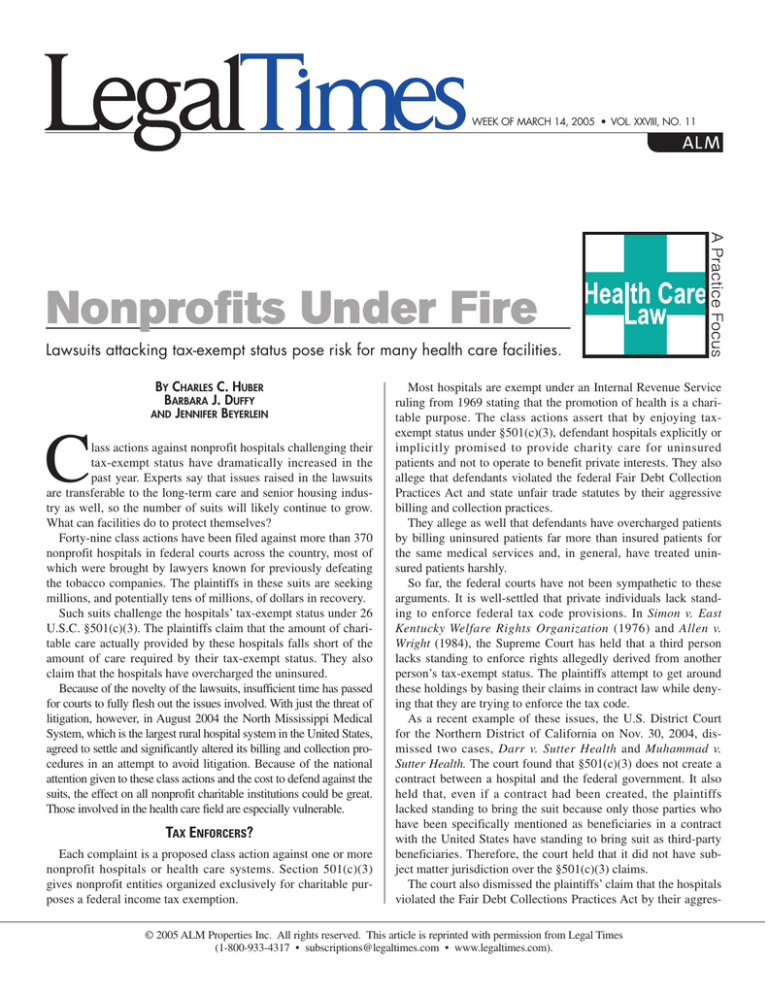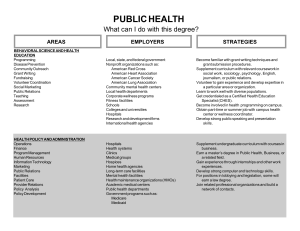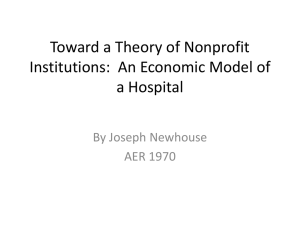B C C. H J. D
advertisement

WEEK OF MARCH 14, 2005 • VOL. XXVIII, NO. 11 Nonprofits Under Fire Lawsuits attacking tax-exempt status pose risk for many health care facilities. BY CHARLES C. HUBER BARBARA J. DUFFY AND JENNIFER BEYERLEIN C lass actions against nonprofit hospitals challenging their tax-exempt status have dramatically increased in the past year. Experts say that issues raised in the lawsuits are transferable to the long-term care and senior housing industry as well, so the number of suits will likely continue to grow. What can facilities do to protect themselves? Forty-nine class actions have been filed against more than 370 nonprofit hospitals in federal courts across the country, most of which were brought by lawyers known for previously defeating the tobacco companies. The plaintiffs in these suits are seeking millions, and potentially tens of millions, of dollars in recovery. Such suits challenge the hospitals’ tax-exempt status under 26 U.S.C. §501(c)(3). The plaintiffs claim that the amount of charitable care actually provided by these hospitals falls short of the amount of care required by their tax-exempt status. They also claim that the hospitals have overcharged the uninsured. Because of the novelty of the lawsuits, insufficient time has passed for courts to fully flesh out the issues involved. With just the threat of litigation, however, in August 2004 the North Mississippi Medical System, which is the largest rural hospital system in the United States, agreed to settle and significantly altered its billing and collection procedures in an attempt to avoid litigation. Because of the national attention given to these class actions and the cost to defend against the suits, the effect on all nonprofit charitable institutions could be great. Those involved in the health care field are especially vulnerable. TAX ENFORCERS? Each complaint is a proposed class action against one or more nonprofit hospitals or health care systems. Section 501(c)(3) gives nonprofit entities organized exclusively for charitable purposes a federal income tax exemption. Most hospitals are exempt under an Internal Revenue Service ruling from 1969 stating that the promotion of health is a charitable purpose. The class actions assert that by enjoying taxexempt status under §501(c)(3), defendant hospitals explicitly or implicitly promised to provide charity care for uninsured patients and not to operate to benefit private interests. They also allege that defendants violated the federal Fair Debt Collection Practices Act and state unfair trade statutes by their aggressive billing and collection practices. They allege as well that defendants have overcharged patients by billing uninsured patients far more than insured patients for the same medical services and, in general, have treated uninsured patients harshly. So far, the federal courts have not been sympathetic to these arguments. It is well-settled that private individuals lack standing to enforce federal tax code provisions. In Simon v. East Kentucky Welfare Rights Organization (1976) and Allen v. Wright (1984), the Supreme Court has held that a third person lacks standing to enforce rights allegedly derived from another person’s tax-exempt status. The plaintiffs attempt to get around these holdings by basing their claims in contract law while denying that they are trying to enforce the tax code. As a recent example of these issues, the U.S. District Court for the Northern District of California on Nov. 30, 2004, dismissed two cases, Darr v. Sutter Health and Muhammad v. Sutter Health. The court found that §501(c)(3) does not create a contract between a hospital and the federal government. It also held that, even if a contract had been created, the plaintiffs lacked standing to bring the suit because only those parties who have been specifically mentioned as beneficiaries in a contract with the United States have standing to bring suit as third-party beneficiaries. Therefore, the court held that it did not have subject matter jurisdiction over the §501(c)(3) claims. The court also dismissed the plaintiffs’ claim that the hospitals violated the Fair Debt Collections Practices Act by their aggres- © 2005 ALM Properties Inc. All rights reserved. This article is reprinted with permission from Legal Times (1-800-933-4317 • subscriptions@legaltimes.com • www.legaltimes.com). sive debt collection practices. It held that the hospitals did not fall under the statute’s definition of debt collector and were not governed by the statute. Although the court dismissed the federal claims, it declined to exercise jurisdiction over the state law claims. Consequently, plaintiffs may still bring their suits in state court. Since November, several other district courts have also dismissed similar suits. In addition, other courts will hear similar motions in the next few months. Still, even if the federal courts dismiss the federal claims and follow the California district court, the lawsuits will probably continue in state forums. The Class Action Fairness Act of 2005, which in general pushed more class actions into federal court, will most likely not change the federal courts’ decisions to decline jurisdiction. The act allows a federal court to decline jurisdiction if the majority of the class members are citizens of the forum state, which is generally true in these lawsuits. Because so few courts have addressed the plaintiffs’ novel claims, however, federal claims could continue to gain momentum. For this reason, it is imperative that other nonprofit organizations be prepared to defend against such lawsuits. A TOTAL ABOUT-FACE The class actions have affected more than just tax-exempt hospitals. The American Hospital Association, the hospitals’ trade group, is named as a co-defendant in many lawsuits. The plaintiffs claim that the AHA is a co-conspirator in the overly aggressive billing and collection practices instigated by the hospitals. The association responded to these charges by issuing a statement that its billing practice and debt collection guidelines were the result of federal regulations and do not violate federal law. In response to the lawsuits, media attention, and association statements, the Office of Inspector General for the Department of Health and Human Services issued a letter on Feb. 2, 2004, stating that, in fact, no authority prohibits or restricts hospitals from offering discounts to uninsured patients unable to pay their hospital bills. Similarly, the Office of Inspector General stated that no rule or regulation requires a hospital to engage in any particular collection practice or to engage in any collection practice at all against those patients unable to pay their medical bills so long as the hospital’s practice is a part of the hospital’s indigent policy. Thereafter, the AHA changed its billing and collection practice guidelines. It advises hospitals to help patients qualify for existing charity care programs, make medical care more affordable for patients with limited means by offering discounts to patients who do not qualify for charity care, and ensure that patient accounts are pursued fairly and consistently. Many hospitals started adopting these new practices during the summer of 2004. This total about-face evidences the seriousness of the present lawsuits and their potential to stir the IRS or state revenue departments to investigate organizations that charge more to uninsured individuals. To protect themselves from lawsuits and further scrutiny, all nonprofit organizations should adhere to the IRS’s guidelines governing tax exemptions. Moreover, it would be wise for all nonprofit organizations in the health care arena to follow the AHA’s billing and debt collection guidelines. ELDER CARE FACILITIES AT RISK Nonprofit nursing homes, senior housing, and other elder care facilities are potential targets for the not-for-profit class actions. Such organizations are exempt under the same federal statute as the hospitals at the center of the class actions. In comparison to the hospitals, however, these entities are more vulnerable because of the specificity of IRS rulings determining their tax-exempt status. The IRS ruled in 1979 that an elder care organization operates for charitable purposes under §501(c)(3) if it provides housing to elderly persons at the lowest feasible cost and maintains in residence those tenants who subsequently become unable to pay its monthly fees. Potential plaintiffs might argue that facilities caring for the elderly have a more precise “contract” to follow while providing for those who cannot pay for care than the hospitals involved in the current litigation. Consequently, elder care facilities should be prepared to deflect such lawsuits before they become a problem. Furthermore, many states have specific tax-exempt codes for organizations providing care or housing to the elderly population. Such statutes are generally not at issue in the hospital litigation, but a plaintiff could more easily allege a violation of a purported state contract if such a statute is applicable. Moreover, because such facilities are vulnerable to all of the current federal claims, plaintiffs’ attorneys could easily transfer the hospital lawsuits onto this industry. AVOIDING SUITS To guard against the threat of similar class actions, elder care facilities should specifically address the requirements of the statutes under which they receive their exempt status. Because most nonprofit organizations receive exemptions from the federal government for charity care under §501(c)(3), they need to ensure that they provide the amount of charity care envisioned by the IRS when it granted the exemption. In addition, nonprofit organizations should apply their resources to benefit residents or improve their facilities. A common allegation in the class action claims is that hospitals accumulate great wealth, which is used to pay their executives high salaries rather than relieving the burden on the uninsured. The IRS ruling requires facilities to provide elderly housing at the lowest feasible cost. Failure to spend resources to follow this mandate could provide more grounds for a lawsuit, in addition to the kind of claims made in the current class action litigation. Likewise, if a nonprofit elder care organization repeatedly discharges residents because of their inability to pay, it may find itself at the center of this sort of lawsuit. In sum, the increase of these class actions against hospitals and the accompanying public attention makes it probable that all nonprofit arenas will see an influx of such litigation. Because elder care facilities provide services to the same class of people involved in the hospital lawsuits, they could be the next targets in this series of litigation. Charles C. Huber and Barbara J. Duffy are partners in the Seattle office of Lane Powell. Huber’s practice includes insurance coverage and major personal injury matters. Duffy heads the firm’s long-term care and senior housing practice group. Jennifer Beyerlein is an associate at the firm. They can be reached at huberc@lanepowell.com, duffyb@lanepowell.com, and beyerleinj@lanepowell.com respectively.






